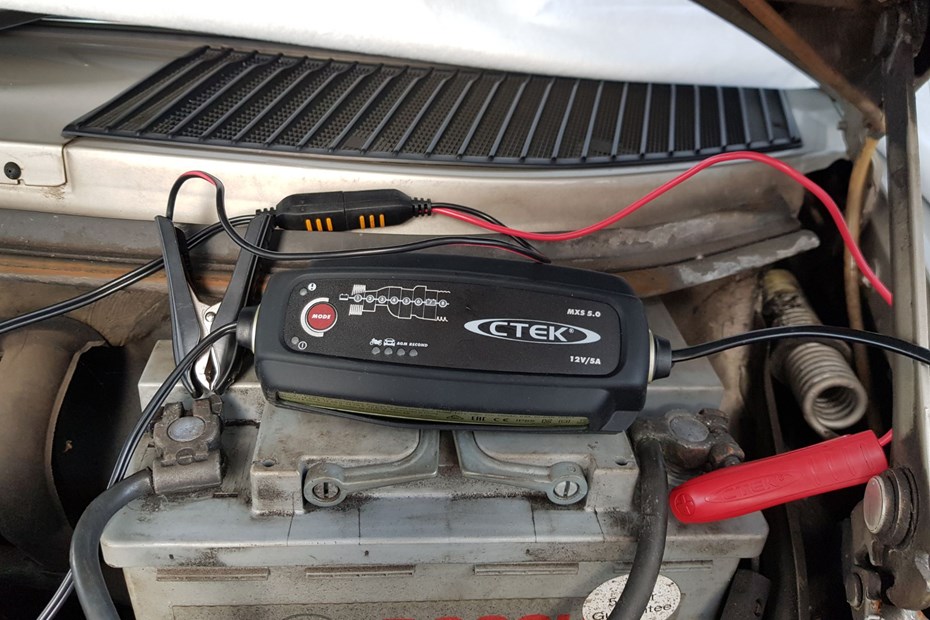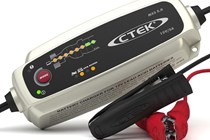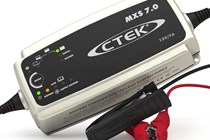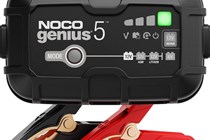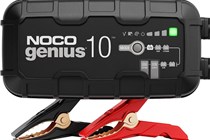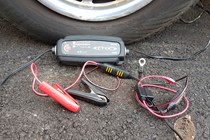The CTEK MXS 5.0 trickle charger is one of the more popular battery chargers on sale. It sits between the less powerful MXS 0.8 and 3.8 models, yet isn’t as powerful as the higher-end 7.0 and 10 models. It’s a mid-range example that should be usable with most cars, as well as motorcycles and other small vehicles.
You might be wondering what a trickle charger is exactly? Picture the situation: you have to leave your car sitting for a prolonged amount of time. You might be away on a trip, you might have to store the car in someone else’s garage or driveway whilst you have work done to your home. You might even have to a car in a private underground car park below your flat for a while.
Such is life. But the worst thing that can happen is you come back to your car, and the battery is flat. You could of course, take the battery out. But this can be a hassle. So, another answer is to invest in a trickle charger, should a long parking or storage situation occur.
The CTEK MXS 5.0 is made by Swedish manufacturer CTEK, and each product is designed to cope with both ends of harsh temperatures. It should keep your battery well-conditioned from an icy cold snap to Sahara heat. To top it off, because it’s small and only needs a plug socket, it’s a portable way of keeping your battery in working order.
A great quality, trusty trickle charger that has your back, should a car be off the road for some time. It’s a shame about the flaws…
Verdict score: 4/5
Worth the investment
Pros
- Very good build quality
- Works perfectly during cold snaps
Cons
- Cable is far too short
| Dimensions | 27.2 x 14.4 x 5.4 cm |
| Weight | 200g |
| Connection type | Crocodile clips and ring clips |
| Voltage | 12V |
CTEK MXS 5.0: What’s good?
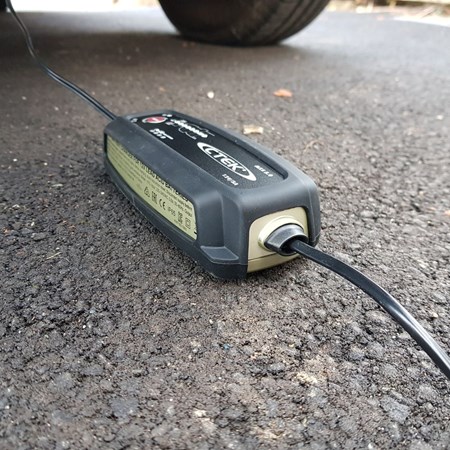
The best part is that the MXS 5.0 is sublimely easy to operate. There are 4 modes you can use, ranging from keeping a motorcycle’s battery charged to reconditioning a larger car battery. I simply set the mode to the car icon and went about my business.
But before I did, I couldn’t get over just how much of a premium product it felt like. It becomes quite clear that CTEK manufactures its products to feel well-suited to its popular market. To give an idea of who that might be, a lot of premium sports and supercar dealers will use them to keep the batteries of Porsches and Ferraris in check.
You get two types of clips to connect to the battery terminals. You either get a pair of crocodile clips or a pair of eyelet clips. The idea of the latter is that you can disconnect the terminals and slot them on the battery before re-connecting the terminals. Either works just fine and connecting takes seconds. The only downside there is the crocodile clips don’t open as far apart as you’d want them to, and they’re pretty stiff.
It was reassuringly easy to monitor too. Lights indicated at 7 and 8 on the unit depict that the battery is at full or nearly full charge, and the MXS 5.0 goes into its trickle stage, whereby it keeps the battery charge topped up at around 95% and above.
Of course, testing a trickle charger takes its time. The whole idea of the things is that you can leave them for a long time while it conditioned the battery.
CTEK MXS 5.0: The Test

So, let’s set the course straight: I have to leave my car parked up for a while. A fuel pump issue means it’s not driveable, and a part, the fuel pump relay, is currently being refurbished. I have a circuit to bypass it so I can start the car and regularly run it up to temperature.
Of course, in between, the MXS 5.0 is hooked up. Two weeks pass of it keeping the battery in check, I disconnect, run the engine for about 10 minutes, and hook it back up. It started up the first time without hesitation, a big plus point.
About a week and a half later, the same result happens again. So far, this is reassuring me that the CTEK is doing its job and doing it well since it regularly displays 7 or 8 on the unit indicator. I continue this cycle for another couple of weeks before giving the CTEK its ultimate test, taking it away altogether.
After two and a half weeks of it not being connected, I fire up the engine again. And sure enough, it does it without any hesitation whatsoever. This got me wondering whether the CTEK either maintained the battery to a constantly healthy point, or whether Bosch store immortal energy in car batteries.
It’s also worth pointing out that although I had the charger sat underneath the car, it coped well with the frosty weather temperatures and still kept displaying a green light. So, it’s reassuring to know it can manage well outdoors, even if most will be in garages.
You have to bear in mind that wealthy people live by these things. That’s simply because they’ll accumulate a load of classic and sports cars. And because they won’t see much use throughout the year, the batteries are kept conditioned by CTEK or NOCO trickle chargers while stored in a heated garage.
CTEK MXS 5.0: The Bad
Granted, this is an issue tailored explicitly to where I live. But the cable isn’t long enough. The length between the crocodile clips and charger unit is manageable since I could rest the charger flat on the ground. But the cable leading to the plug? It’s only about a metre long. I had to employ a long extension cable to stretch to the nearest plug socket, and then there was the hassle of waterproofing the sockets.
You can get a 2.5 metre extension cable from CTEK, but that’s an extra £20. Even with the most financially neutral mindset, you simply cannot ignore how extortionate that is. You don’t get the extension cable, or a lot of different extras, even after splashing out on a premium battery charger. The test piece I was given did have a load of extra pieces. But it does quickly strip you of cash.
The charger unit, crocodile and eyelet clips come as standard. But I’ve got an extra set of crocodile clips with a traffic light indicator, and I have an extra set of eyelet clips as well (without traffic light indicator). Together, those extra clips come in at an extra £20.
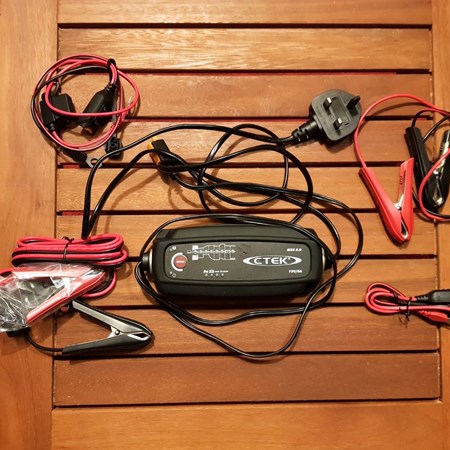
Then there’s the rubber protective case. It’s brilliant, it grips the ground well and stops your charger from getting scratched. But it’s yet another £18 and an item that isn’t included as standard.
Like the vast range of modern cars, CTEK chargers have optional extras, which can add to your bill. If we add up what equipment I’ve been given, plus a 2.5m extension cable, the total would be around £160.
And given the retail price of an MXS 10 is £180, it does leave you questioning. But on the flip side, you have precisely the same issues with every other CTEK MXS charger. You don’t get a lot of helpful equipment as standard. This is a crying shame because for the job it does in the low temperatures over winter, it’s so recommendable.
More items to consider
Best for varying conditions
Pros
- Winter/very cold mode
- Icons are easier to understand
Cons
- The 5.0 does everything it does
Best value trickle charger
It has a handy temperature sensor which can work against under-charging in the cold and over-charging while hot. NOCO even say it can be used to charge tractors, true versatility on display.
Pros
- Compact and powerful
- Comes with temperature sensor
Cons
- Modes are slightly harder to understand
The most comprehensive battery charger
You do get a few more modes with the Genius 10 which can cater to more battery types and in 6V and 12V supplies.
Pros
- Slightly more comprehensive than the Genius 5
- Very powerful for its size
Cons
- Both the NOCO and CTEK chargers suffer from the same equipment issues
Who tested the CTEK MXS 5.0?
This test was conducted by Aaron Hussain. He is a commercial content writer for Bauer Media’s two automotive brands, Parkers and CAR. His passion for classic cars and good maintenance made him an ideal writer to put the CTEK MXS 5.0 in the Parkers rankings. But of course, it was convenient to test in order to stop his car battery from going flat.
How the CTEK MXS 5.0 was tested
As briefly mentioned earlier, my classic car, a 1985 Mercedes 230E, is off the road and undergoing work. The CTEK was tested simply by keeping the battery in check over the course of a few months. At the time of writing, it is still in use. This is due to a Mercedes specialist refurbishing the fuel pump relay, which I’ve been advised will take a short while. Luckily, no jump starter was required throughout the ordeal.
Aaron Hussain is a commercial content writer at Bauer Media writing for Parkers and CAR. He is obsessed with classic cars and anything with a fascinating story to tell.
Sign up to the Parkers Newsletter to keep up to date with more of the latest reviews, news, and recommendations from the Parkers team.
Just so you know, while we may receive a commission or other compensation from the links on this page, we never allow this to influence product selections – read why you should trust us
Just so you know, we may receive a commission or other compensation from the links on this website - read why you should trust us.


